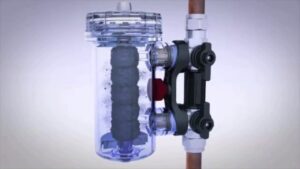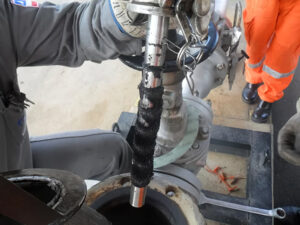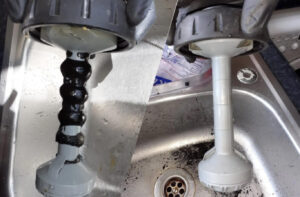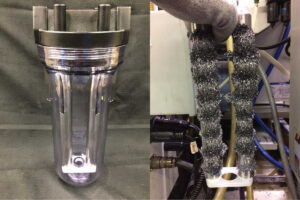If you have a central heating system, installing a magnetic boiler filter is one of the best ways to protect your boiler and improve efficiency. But where exactly should you install it to maximize performance?
In this complete guide, as a professional magnetic filter manufacturer, we’ll cover everything you need to know about where to fit a magnetic boiler filter for optimal debris collection and heating system protection.

Why Install a Magnetic Boiler Filter?
Before jumping into the ideal filter location, let’s briefly go over why you need one in the first place.
Over time, all heating systems accumulate black iron oxide sludge. This magnetite builds up inside radiators and pipes due to corrosion. And when pieces break free, they circulate until eventually clogging your boiler.
A magnetic boiler filter collects this iron oxide debris before it reaches your boiler. Without one, you risk reduced efficiency, breakdowns, and even complete system failure.
Benefits include:
- Prevents boiler component damage from circulating debris
- Improves heating efficiency
- Extends the lifespan of the entire system
- Reduces energy bills
- Lowers carbon emissions
Clearly, a small investment in a magnetic filter can lead to huge savings while keeping your family warm.
Now let’s look at exactly where experts recommend installing it.
Where’s the Best Place to Install a Magnetic Boiler Filter?
The ideal magnetic boiler filter location is on the heating system’s return pipe, as close to the boiler as possible.
This placement ensures maximum magnetite collection right before water reenters the boiler.
Here’s why this location is best:
Return Pipe
Every central heating system has a flow pipe carrying hot water to radiators, and a return pipe bringing cooled water back to reheat.
Installing the filter on the return line catches debris immediately before the water loops back into the boiler.
Close to Boiler
Mounting the magnetic filter near the boiler prevents magnetite from circulating through the entire home before getting filtered out. This also minimizes pipe length for improved efficiency.
Accessibility
While fitting the filter close to the boiler is optimal, also consider an accessible area allowing convenient servicing and cleaning.
Bypass Valve
Quality magnetic boiler filters have an integrated bypass valve. This temporary bypass lets water keep flowing during filter maintenance.
Alternative Magnetic Filter Locations
While the return pipe by the boiler is the prime area, alternative areas can also work:
Main Circuit
If boiler access is limited, placing the filter on the main circuit pipe collects debris but with less efficiency.
Hot Water Cylinder
Installing on the hot water cylinder return line also filters debris. However, it only cleans that water line, missing the heating system.
The key is installing your magnetic boiler filter on a return line, not the outgoing supply. This method captures rubble right before the water reenters the boiler.
Now let’s look at the step-by-step process for correctly mounting your new filter.
How to Install a Magnetic Boiler Filter
Once you select an optimal and accessible filter location, installation takes just minutes.
Here is the basic process:
Step 1) Turn off central heating system power and drain enough water to expose installation pipes.
Step 2) Selecting suitable connective fittings like compression fittings, thoroughly clean installation points.
Step 3) Following manufacturer guidelines, mount the boiler filter directly onto the return pipe.
Step 4) Secure all fittings, double-checking alignment and supports.
Step 5) Refill system, pressurize, and thoroughly bleed all radiators and pipes of air.
And that’s it! As you can see, plumbing in a magnetic filter is a straightforward job. But due to system drainage/refill, consider having your heating technician handle it instead.
Now let’s look at why professionals strongly urge using a magnetic boiler filter.
Why Industry Experts Recommend Magnetic Filters
Heating engineers widely agree that magnetic filters should be standard in all boiler systems.
With modern boilers having condensed heat exchangers, they are exceptionally vulnerable to magnetite. This superheated debris gets embedded between plates, reducing efficiency and component lifespans.
So respected industry bodies like ADEY Professional Heating Solutions emphasize filters’ importance for homeowners. Their decades of research show that without magnetic filtration, debris accumulation leads to:
- Annual boiler repairs averaging $720
- Replacement costs of $3,000 or more
- Shortened boiler lifespans by 2-5 years
However, ADEY reports that installing a magnetic filter can extend a boiler’s lifespan by 5+ years. Their studies found it lowers annual repair bills by 10-20% as well.
Clearly, fitting even an inexpensive magnetic boiler filter pays massive dividends. And placing it in the central heating return line close to your boiler ensures optimal performance.
Locating Your Central Heating Return Pipe
If you’re unsure which pipe is the return line, there are two easy ways to identify it:
- Touch test – After running your central heating, touch pipes near your boiler. The return pipe transfers heat from radiators back to the boiler, so it will be warm while supply pipes stay cool.
- Flow direction – The boiler sends hot water out through the supply or “flow” pipe. So trace direction to determine which line returns water.
Once you’ve located the return pipe, fitting a magnetic filter nearby is a smart investment. It saves on repairs, improves efficiency, and extends boiler lifespan.
Finding the Right Magnetic Boiler Filter
With filter location covered, choosing the right magnetic boiler filter model is next.
Keep these tips in mind when selecting yours:
- Match strength to system size
- Check manufacturer pipe size compatibility
- Consider filter cleaning difficulty
- Compare built-in bypass valves
- Choose suitable temperature/pressure ratings
- Verify required standard certifications
Installing a properly sized and rated magnetic filter suitable for your make and model heating system keeps your boiler working optimally.
Paired with correct positioning on the central heating return, this small device prevents thousands in repairs and replacements. For a few pounds, magnetic filtration is one of the most cost-effective efficiency upgrades saving you money monthly.
Wrapping Up
Protecting your expensive boiler while cutting energy bills is easy with a properly installed magnetic filter.
While these come in different shapes and sizes, experts agree fitting it on the central heating return pipe near the boiler works best. This placement maximizes system debris collection for improved efficiency and equipment longevity.
So don’t wait until your boiler breaks or skyrocketing bills arrive. Take proactive steps by installing a magnetic boiler filter this year. Given the massive savings and extended equipment lifespan, it’s one of the wisest energy-saving upgrades available.





